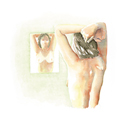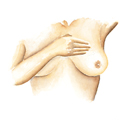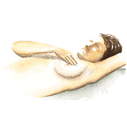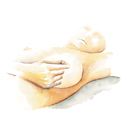Breast Self Examination for prevention of Breast Cancer
Breast self-examination (BSE) is a very important part of every adult womans personal health regimen. Many physicians and cancer organizations recommend that BSE be performed once each month beginning at age 20 and should continue each month throughout a womans lifetime.
In addition to BSE, adult women should receive regular physician-performed clinical breast exams. The American Cancer Society recommends women 40 years of age receive a screening mammogram every one to two years. Beginning at age 50, mammography should be performed every year.
The Best Time to Perform Breast Self-Exam
Menstruating women: Hormonal changes due to the menstrual cycle may make the breasts more lumpy or swollen. Women who are menstruating should perform breast self-exam from a few days to about a week after menstruation (period) has ended, when breasts are usually less tender or swollen.
Women who are no longer menstruating: should do their BSE on the same day every month. Try to pick a day that is easy to remember, such as the first or fifteenth of every month, and make that the day each month for breast self-exam.
Women using oral contraceptives: are encouraged to do their BSE each month on the day they begin a new package of pills.
Breast Changes and Warning Signs To Watch for During Breast Self-Exam:
- Any new lump or hard knot found in the breast or armpit
- Any lump or thickening that does not shrink or lessen after your next period
- Any change in the size, shape or symmetry of your breast
- A thickening or swelling of the breast
- Any dimpling, puckering or indention in the breast
- Dimpling, skin irritation or other change in the breast skin or nipple
- Redness or scaliness of the nipple or breast skin
- Nipple discharge (fluid coming from your nipples other than breast milk), particularly if the discharge is bloody, clear and sticky, dark or occurs without squeezing your nipple
- Nipple tenderness or pain
- Nipple retraction: turning or drawing inward or pointing in a new direction
- Any breast change that may be cause for concern
If any of these changes are noted, women should see their physicians as soon as possible for clinical evaluation. However, in the majority of cases (80%), breast lumps and changes are not cancer. Women should not allow their fear of breast cancer keep them from telling their physician or healthcare provider about a lump or change they have found.
BSE Method While Standing in Front of a Mirror
Because the upright position can make it easier to check the upper and outer portions of the breasts and armpit, breast self-examination (BSE) should be performed standing up in addition to lying down. Looking (inspection) should take place in front of a mirror in a well-lit area. A tall dressing mirror is often best. While standing in front of a mirror, undress down to the waist.
 |
Place the arms at the sides. Check the breasts for any changes in size, shape or position, dimpling or puckering of the skin, pushed-in or misshapen nipples, other changes in the nipple, redness, swelling or other irregularities. Then, repeat this process with the hands on the hips, pressing firmly to flex the chest (pectoral muscles). Bend forward with the hands on the hips and note any irregularities. |
 |
Raise the arms overhead or put the hands behind the head. Turn to each side to check the breasts in profile. Note any changes in symmetry between the right and left breast. Remember, it is often normal for women to have one breast that is larger or a different shape than the other. |
 |
Examine each breast separately and feel for any new lumps, changes, or irregularities. Use the pads of the fingers, not the tips, and practice the patterns of examination described in the above section (up and down line, spiral, wedge pattern). The nipple should also be examined during this time. First, squeeze the nipple and check for any nipple discharge . Then push the nipple deep into the hollow beneath it. Note any unusual resistance, hardness or lump beneath the nipple. |
During the standing portion of the exam, the lymph nodes in each armpit and surrounding areas under the arm should be carefully examined. Lymph nodes are normally about the size of kidney beans. Sometimes the lymph nodes may be enlarged by a non-cancerous infection. Occasionally, lymph node enlargement may be caused by a cancerous process. As with any breast or nipple changes, women should report any lymph node changes or enlargement to their physicians.
In addition to standing, breast self-examination (BSE) should also be performed while lying down. Women should use the pattern of examination described in the above section and should ask their physicians if they have questions about performing BSE. The video program also shows the proper BSE technique.
 |
Lie down with a pillow or folded towel under the right shoulder and place the right arm behind the head. Check the entire breast and armpit area using the pads of the first three middle fingers on the left hand to feel for lumps, changes, or irregularities in the right breast. Press firmly enough to know how the breast feels. A firm ridge in the lower curve of each breast is normal. The exam should then be repeated on the left breast, using the finger pads of the right hand (the pillow or folded towel should also be moved under the left shoulder at this time). |
 While performing BSE lying down, the nipple should also be checked for any changes. After making an initial examination, gently squeeze the nipple to check for any discharge of fluid. Note any changes in appearance, discharge (including the color and whether the discharge occurs spontaneously or by squeezing), or cracking.
While performing BSE lying down, the nipple should also be checked for any changes. After making an initial examination, gently squeeze the nipple to check for any discharge of fluid. Note any changes in appearance, discharge (including the color and whether the discharge occurs spontaneously or by squeezing), or cracking.
Nipple fluid that is green or yellow is usually normal. Nipple fluid that is bloody, dark or clear and sticky is considered abnormal (although most suspicious nipple discharges are found to be caused by non-cancerous conditions such as papillomas). In approximately 10% of all cases, nipple discharge is due to a cancerous lesion. In women less than 30 years of age, less than 10% of nipple discharge is due to cancer. Nevertheless, any persistent nipple discharge should be reported to a physician for clinical evaluation.
With thanks to http://imaginis.com
